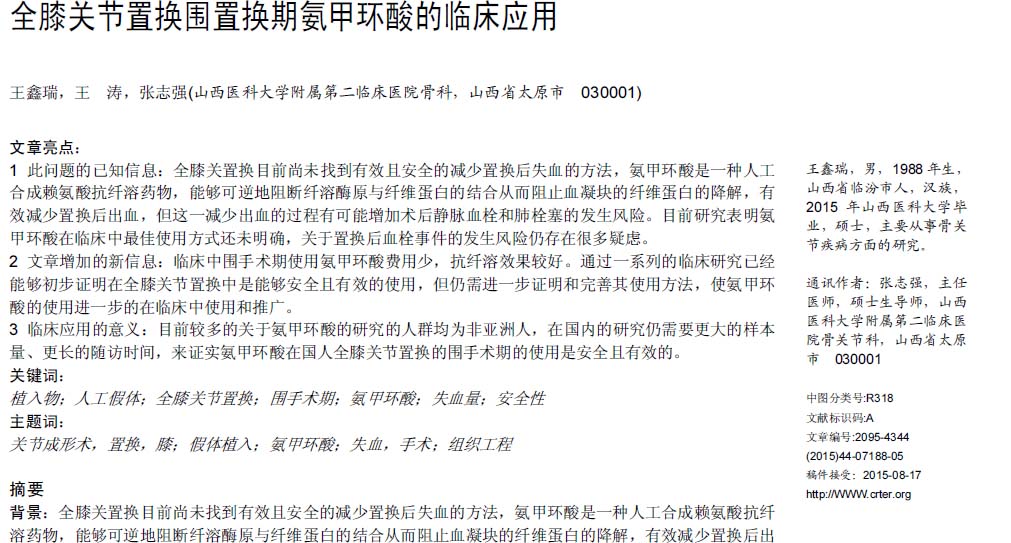|
[1] 吕厚山.现代人工关节外科学[M].北京:人民卫生出版社,2006.
[2] Bierbaum BE,Callaghan JJ,Galante JO,et al.An analysis of blood management in patients having a total hip or knee arthroplasty.J Bone Joint Surg Am.1999; 1: 2.
[3] Lange M, Van Aken H, Westphal M. Prevention and treatment of major blood loss. N Engl J Med. 2007;357(12):1260-1261.
[4] Fraser IS, Porte RJ, Kouides PA, et al. A benefit-risk review of systemic haemostaticagents: part 1: in major surgery. Drug Saf. 2008;31(3):217.
[5] Ramsey EZ, Smith KM, Flynn JD. Prophylaxis of perioperative blood loss. Orthopedics. 2006;29(8):689.
[6] Tobias JD. Strategies for minimizing blood loss in orthopedic surgery. Semin Hematol. 2004;41(1 Suppl 1):145.
[7] Levy JH. Novel pharmacologic approaches to reduce bleeding. Can J Anaesth. 2003;50(6 Suppl):S26.
[8] Pulido L, Ghanem E, Joshi A, et al. Periprosthetic joint infection: the incidence, timing,and predisposing factors. Clin Orthop Relat Res. 2008;466(7):1710.
[9] Lemaire R. Strategies for blood management in orthopaedic and trauma surgery. J Bone Joint Surg Br. 2008; 90-B: 1128-1136.
[10] Eroglu A, Uzunlar H,Erciyes N.Comparison of hypotensive epidural anesthesia and hypotensive total intravenous anesthesia on intraoperative blood loss during total hip replacement. J Clin Anesth. 2005;6: 420-425.
[11] Zufferey P,Merquiol F,Laporte S,et al.Do antifibrinolytics reduceallogeneic blood transfusion in orthopedic surgery. Anesthesiology.2006; 5:1034-1046.
[12] Borghi B,Casati A,Iuorio S,et al.Effect of different anesthesia techniques on red blood cell endogenous recovery in hip arthroplasty.J Clin Anesth.2005; 2:96-101.
[13] Burkart BC, Bourne RB, Rorabeck CH, et al. The efficacy of tourniquet release in blood conservation after total knee arthroplasty.Clin Orthop. 1994; 299: 147-152.
[14] Benoni G, Fredin H. Fibrinolytic inhibition with tranexamic acid reduces blood loss and blood transfusion after knee arthroplasty:a prospective,randomised,double-blind study of 86 patients. J Bone Joint Surg Br. 1996;78(3):434-440.
[15] Dowd NP, Karski JM, Cheng DC .Pharmacokinetics of tranexamic acid during cardiopulmonary bypass. Anesthesiology. 2002;97(2):390-399.
[16] Fiechtner BK, Nuttall GA, Johnson ME. Plasma tranexamic acid concentrations during cardiopulmonary bypass. Anesth Analg. 2001;92(5);1131-1136.
[17] Dalmau A, Sabate A, Acosta F. Tranexamic acid reduces red cell transfusion better than epsilon-aminncaproic acid or placebo in liver transplantation. Anesth Analg. 2001;(1):29-34.
[18] Eriksson O, Kjellman H, Pilbrant A, et al.Pharmacokinetics of tranexamic acid after intravenous administration to normal volunteers. Eur J Clin Pharmacol. 1974; 5: 375-380.
[19] Andersson L, Eriksson O, Hedlund PO, et al. Special considerations with regard to the dosage of tranexamic acid in patients with chronicrenal diseases. Urol Res. 1978; 2: 83-88.
[20] Ahlberg A, Eriksson O, Kjellman H. Diffusion of tranexamic acid to the joint. Acta Orthop Scand. 1976; 47: 486-488.
[21] Benoni G, Lethagen S, Fredin H. The effect of tranexamic acid on local and plasma fibrinolysis during total knee arthroplasty. Thromb Res. 1997; 3:195-206.
[22] Astedt B, Liedholm P, Wingerup L. The effect of tranexamic acid on the fibrinolytic activity of vein walls . Ann Chir Gynaecol. 1978;6: 203 -205.
[23] Maniar RN, Kumar G, Singhi T, et al. Most effective regimen of tranexamic acid in knee arthroplasty: a prospective randomized controlled study in 240 patients. Clin Orthop. 2012; 9:2605-2612.
[24] Hiippala S,Strid L,Wennerstrand M,et al.Tranexamieacid(Cyk-lokapron)reduces perioperative blood loss associated with total knee arthroplasty.Br J Anaesth. 1995;74(5):534-537.
[25] Zohar E, Fredman B, Ellis M, et al. A comparative study of the postoperative allogeneic blood-sparing effect of tranexamic acid versusacute normovolemic hemodilution after total knee replacement .Anesth Analg.1999;6:1382-1387.
[26] Jansen AJ, Andreica S, Claeys M, et al. Use of tranexamic acid for aneffective blood conservation strategy after total knee arthroplasty.Br J Anaesth. 1999;4: 596-601.
[27] Charoencholvanich K, Siriwattanasakul P. Tranexamic acid reduces blood loss and blood transfusion after TKA: a prospective randomized controlled trial. Clin Orthop Relat Res. 2011;469(10):2874-2880.
[28] 周林,李乃戈,周鹏.氨甲环酸对全膝关节置换术中及术后失血量的影响[J].西南国防医药,2011, 21(9):988-991.
[29] Engel JM, Hohaus T, Ruwoldt R,et al. Regional hemostatic status and blood requirements after total knee arthroplasty with and without tranexamic acid or aprotinin . Anesth Analg. 2001; 3:775-780.
[30] Ido K, Neo M, Asada Y, et al. Reduction of blood loss using tranexamic acid in total knee and hip arthroplasties. Arch Orthop Trauma Surg. 2000;9:518-520.
[31] Good L,Peterson E,Lisander B. Tranexamic acid decreases external blood loss but not hidden blood loss in total knee replacement. Br J Anaesth. 2003; 5:596-599.
[32] Camarasa MA, Olle G, Serra-Prat M, et al. Efficacy of aminocaproic, tranexamic acids in the control of bleeding during total knee replacement: a randomized clinical trial. Br J Anaesth. 2006; 5:576-582.
[33] Molloy DO,Archbold HA,Ogonda L,et al. Comparison of topical fibrin spray and tranexamic acid on blood loss after total knee replacement: a prospective, randomised controlled trial. J Bone Joint Surg Br. 2007;3:306-309.
[34] Ellis MH,Fredman B,Zohar E,et al. The effect of tourniquet application, tranexamic acid, and desmopressin on the procoagulant and fibrinolytic systems during total knee replacement. J Clin Anesth. 2001;7:509-513.
[35] Alvarez JC,Santiveri FX,Ramos I, et al. Tranexamic acid reduces blood transfusion in total knee arthroplasty even when a blood conser vation program is applied. Transfusion. 2008; 3: 519-525.
[36] Wong J,Abrishami A,El Beheiry H,et al.Topical application of tranexamic acid reduces postoperative blood loos in total knee arthroplasty: a randomized, controlled tril. J Bone Joint Surg Am. 2010;15: 2503-2513.
[37] Alshryda S. Topical ( intra- articular) tranexamic acid reduces bloodloss and transfusion rates following total knee replacement: a randomized controlled trial ( TRANX -K). J Bone Joint Surg Am. 2013;21:1961-1968.
[38] Martin JG,Cassatt KB,Kincaid - Cinnamon KA,et al. Topical administration of tranexamic acid in primary total hip and total knee arthroplasty. J Arthroplasty.2013;10:5.
[39] Mutsuzaki H,Ikeda K. Intra-articular injection of tranexamic acid via a drain plus drain-clamping to reduce blood loss in cementlesstotal knee arthroplasty. J Orthop Surg Res. 2012; 7:32.
[40] Ishida K,Tsumura N,Kitagawa A,et al. Intra -articular injection of tranexamic acid reduces not only blood loss but also knee joint swelling after total knee arthroplasty . Int Orthop. 2011;11: 1639-1645.
[41] Alipour M, Tabari M, Keramati M, et al. Effectiveness of oral Tranexamic acid administration on blood loss after knee artroplasty: a randomized clinical trial.Transfus Apher Sci. 2013;49(3):574-577.
[42] Irwin A, Khan SK, Jameson SS, et al.Oral versus intravenous tranexamic acid in enhanced-recovery primary total hip and knee replacement: results of 3000 procedures. Bone Joint J. 2013; 11: 1556-1561. |
